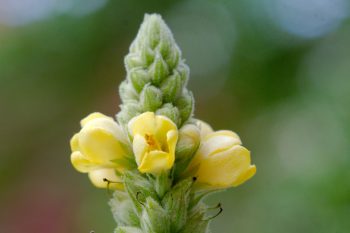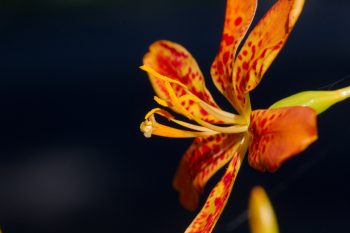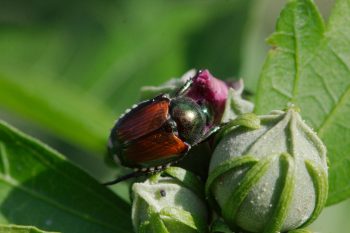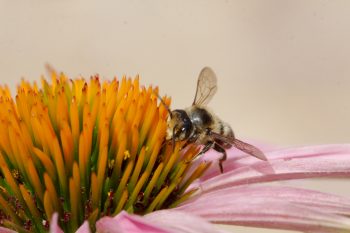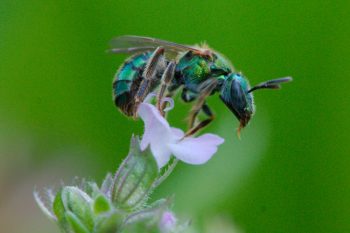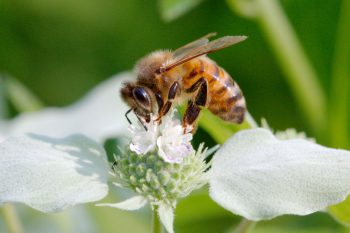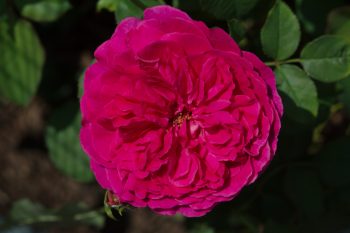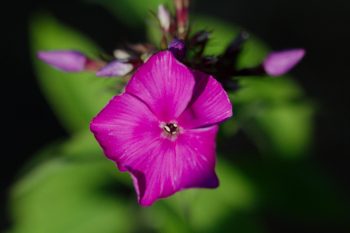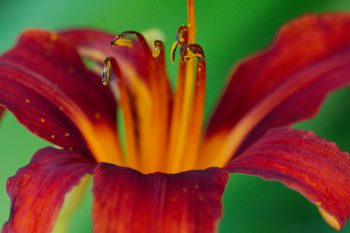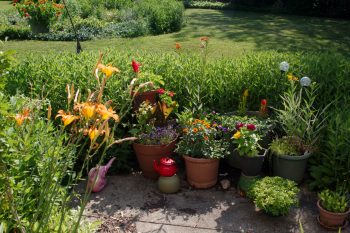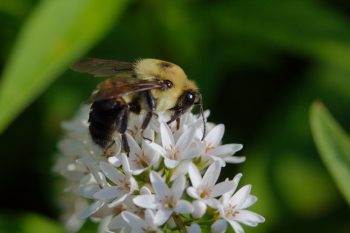Cathy and I were able to get into mom’s gated community today and had a nice visit. We had our temperature taken when we arrived and again when we left and we didn’t actually go inside her building. We visited with her on a bench out front, which was pleasant enough. She showed us the quite she’s almost finished making. It’s for the Ramallah Friends School in Ramallah, in the West Bank, about 8 miles north of Jerusalem. The children at her Friends meeting drew robots and she incorporated their drawings into the quilt. I think it’s turned out quite nicely. For the last third of a year (exactly today), we have only seen her via video chat, except for two times when we met on opposite sides of the fence so she could pass out some tax documents (and one of those times it was pouring rain). It was good to be able to just sit and chat.
Monthly Archives: July 2020
Verbascum thapsus (Common Mullein)
This is the tip of a mullein stalk growing up close to the front of our house. It’s not really in a place I’d choose to plant it, but I left it there for Cathy. She really likes it and we have a fair amount in the hawthorn bed that has become something of a Mediterranean garden this year. It’s funny to hear so many people praise this plant as something the native Americans used medicinally. It may be true, but that only happened after it was introduced from Europe, as it isn’t a native American itself. It’s quite hardy (USDA Zones 3 to 9) and is quite happy in dry, otherwise barren places. This part of our yard really dries out in the summer and is currently rock hard. But along with the Verbascum we have Verbena bonariensis (tall verbena), Lavandula stoechas (Spanish lavender), and Salvia rosmarinus (rosemary), which all do well in rather severe conditions and in fact don’t like being waterlogged.
Iris domestica (Blackberry Lily)
The blackberry lily (Iris domestica, formerly known as Belamcanda chinensis, has beautiful, bright orange flowers above an attractive fan of sword-shaped leaves. It spreads slowly into clumps but mostly spreads by seed, which are distributed both by birds and by wives who really like it in our garden. I first collected seeds in South Carolina many, many years ago and we’ve had it around ever since. We have quite a few at this point and we may be reaching the time when a few of them need to be pulled up (but I’m not sure Cathy’s ready for that yet). They are native from the Himalayas to the Russian far east but do very well here. I like the lighting in this. The bloom is in full sun and the background is the pavement of our street in shadow.
Popillia japonica (Japanese Beetle)
I am definitely not a fan of the Japanese beetle (Popillia japonica), a native of (unsurprisingly) Japan, and instroduced into North America in the early 20th century (first found in the United States in 1916 near Riverton, New Jersey). They are quite destructive of a wide variety of plants, including both ornamental plants (like roses, which they love) and agricultural crops (soybeans, stone fruits, etc.). Their larvae damage lawns, feeding on the roots of grasses. They are, of course, pretty if you can disassociate them from the destruction they cause. But that’s hard for me to do and I don’t really have a lot of sympathy for them. This one is on a rose of Sharon (a.k.a. shrub althea, Hibiscus syriacus).
Resin Bee on Coneflower
I wasn’t happy with most of the pictures I took today, but this one isn’t too bad. I’m pretty sure this is a sculptured resin bee (Megachile sculpturalis), although there are a few other Megachile species it could be (e.g. the flat-tailed leaf-cutter bee, Megachile mendica, which is more common). Regardless, it’s a nice, quiet little bee and it was moving among the coneflowers, along with a few other solitary bees and an occasional honey bee (Apis mellifera). I know that some folks are not fond of bees and don’t like to have them around. With the exception of a few aggressive hornets and wasps, I like having them around. They really rarely sting unless provoked and they are quite pretty to watch on flowers.
Green-Sweat Bee
I was out with my macro on a 25mm extension tube this evening and got a few decent photos of this green bee. I labeled it a cuckoo wasp at first, but now I’m thinking it’s a green-sweat bee (Tribe Augochlorini). But don’t hold me to that. If I get a better identification, I’ll update this post. For now, all I can say for sure is that it’s a bee (Anthophila). I can also say that it’s quite pretty. It was moving around quit a bit and this was the best I could do at ISO 800, f/8, 1/100 second.
Honey Bee (Apis mellifera)
The mountain mint (Pycnanthemum muticum) is starting to bloom. I won’t claim it’s a hive of activity yet, but there’s certainly a bit of a buzz. Mostly I’m seeing honey bees (Apis mellifera) on them so far, but the mountain mint is very attractive to a wide variety of insect life from small beetles and bugs to bees and wasps, and some butterflies. The buddleia next to this tends to get more butterflies, though. It loves the sun and the insects are out in the most fierce in the heat of the day. Not my favorite time to sit there with my camera but it’s sometimes worth the effort.
Rose ‘Munstead Wood’
The second of my three new David Austin roses has started to bloom. It’s called ‘Munstead Wood’ and as you can see, it’s a very double, old fashioned bloom. What you cannot get from the photo is the fragrance, which is very strong. I had to put some hardware cloth around this and one other because the rabbits were biting off the buds and eating them. Now that it’s protected, it’s going to town, with quite a few buds getting ready to open. Of course it’s still a relatively small plant, less than two feet tall, but I’m expecting it to be large enough that it provides a nice point of color in the middle of the garden.
Stock Photo
Over the years I’ve thought about selling photos as stock but I never really got into it. I’m not really sure if I’d actually make any money at it. I sort of doubt it, honestly. I know that now and then I get a reasonably good photo and I certainly enjoy both taking and looking at them. But whether they are actually suitable for stock is another matter. And of course it isn’t just that. They would have to be found among the hundreds of thousands of other stock photos. I’m sure there are ways to increase your chances but I’m not sure I care enough. So, I’ll just stick to what I do and occasionally post a photo with an attempt at a clever title. This is stock, Matthiola incana.
Fiery Day Lily
I love this day lily. It’s growing by our front walk in the shad of a pink dogwood. It seem really happy there and the colors are more intense in the afternoon, when they house casts its shadow over them. I love these colors, they’re so hot. It’s nice that they are along our walk, so I see them every time I go out the front door. Most of our day lilies are the more standard orange, which is nice, of course. We could do with more like this. Maybe I’ll divide these and spread them around a bit. Maybe I’ll even dig up some of the more aggressive perennials and replace them with these.
Back Patio
These are the containers in the south corner of our back patio, outside our kitchen door. They’re doing pretty well right now and really brighten up the back yard. There’s a lot of green in the yard, which isn’t all that unusual. Having some intense colors is really nice and annuals are so easy. There are some day lilies in the foreground on the left, which are in a container that fell over a few years ago and has been lying on its site for a few years. They don’t seem to mind in the least. There is also a hanging basket with Lantana in the upper left corner. Technically it is a broadleaf evergreen shrub but it isn’t hardy here and is generally grown as an annual.
Common Eastern Bumble Bee (Bombus impatiens)
Pretty much all the flowers in our garden are attractive to insects. I suppose that makes sense, because that’s what flowers are supposed to do, in order to get the insects to (inadvertently) pollinate the flowers. It’s interesting to me, though, that some flowers are attractive to many different insects but some seem to attract a specific subset. Yesterday, I was looking at the Monarda (bee balm) and noticed that the large bees were almost exclusively carpenter bees (Xylocopa virginica). Today I was looking at the gooseneck loosestrife (Lysimachia clethroides) shown here and the large bees were exclusively common eastern bumble bees (Bombus impatiens). Just interesting, that’s all.
On a mostly unrelated note, I really, really don’t recommend you plant any Lysimachia species in your garden. The bees love it, but there are other things they like that aren’t so overwhelming.


